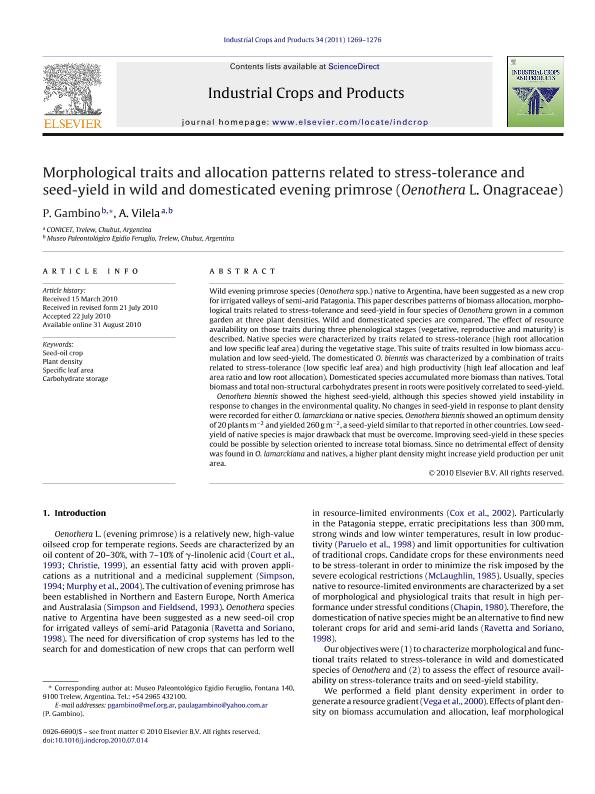Mostrar el registro sencillo del ítem
dc.contributor.author
Gambino, Paula

dc.contributor.author
Vilela, Alejandra Elena

dc.date.available
2019-03-08T19:37:48Z
dc.date.issued
2011-09
dc.identifier.citation
Gambino, Paula; Vilela, Alejandra Elena; Morphological traits and allocation patterns related to stress-tolerance and seed-yield in wild and domesticated evening primrose (Oenothera L. Onagraceae); Elsevier Science; Industrial Crops and Products; 34; 2; 9-2011; 1269-1276
dc.identifier.issn
0926-6690
dc.identifier.uri
http://hdl.handle.net/11336/71257
dc.description.abstract
Wild evening primrose species (Oenothera spp.) native to Argentina, have been suggested as a new crop for irrigated valleys of semi-arid Patagonia. This paper describes patterns of biomass allocation, morphological traits related to stress-tolerance and seed-yield in four species of Oenothera grown in a common garden at three plant densities. Wild and domesticated species are compared. The effect of resource availability on those traits during three phenological stages (vegetative, reproductive and maturity) is described. Native species were characterized by traits related to stress-tolerance (high root allocation and low specific leaf area) during the vegetative stage. This suite of traits resulted in low biomass accumulation and low seed-yield. The domesticated O. biennis was characterized by a combination of traits related to stress-tolerance (low specific leaf area) and high productivity (high leaf allocation and leaf area ratio and low root allocation). Domesticated species accumulated more biomass than natives. Total biomass and total non-structural carbohydrates present in roots were positively correlated to seed-yield.Oenothera biennis showed the highest seed-yield, although this species showed yield instability in response to changes in the environmental quality. No changes in seed-yield in response to plant density were recorded for either O. lamarckiana or native species. Oenothera biennis showed an optimum density of 20plantsm-2 and yielded 260gm-2, a seed-yield similar to that reported in other countries. Low seed-yield of native species is major drawback that must be overcome. Improving seed-yield in these species could be possible by selection oriented to increase total biomass. Since no detrimental effect of density was found in O. lamarckiana and natives, a higher plant density might increase yield production per unit area.
dc.format
application/pdf
dc.language.iso
eng
dc.publisher
Elsevier Science

dc.rights
info:eu-repo/semantics/openAccess
dc.rights.uri
https://creativecommons.org/licenses/by-nc-nd/2.5/ar/
dc.subject
Carbohydrate Storage
dc.subject
Plant Density
dc.subject
Seed-Oil Crop
dc.subject
Specific Leaf Area
dc.subject.classification
Otras Ciencias Biológicas

dc.subject.classification
Ciencias Biológicas

dc.subject.classification
CIENCIAS NATURALES Y EXACTAS

dc.title
Morphological traits and allocation patterns related to stress-tolerance and seed-yield in wild and domesticated evening primrose (Oenothera L. Onagraceae)
dc.type
info:eu-repo/semantics/article
dc.type
info:ar-repo/semantics/artículo
dc.type
info:eu-repo/semantics/publishedVersion
dc.date.updated
2019-03-08T16:47:50Z
dc.journal.volume
34
dc.journal.number
2
dc.journal.pagination
1269-1276
dc.journal.pais
Países Bajos

dc.journal.ciudad
Amsterdam
dc.description.fil
Fil: Gambino, Paula. Museo Paleontológico Egidio Feruglio; Argentina. Consejo Nacional de Investigaciones Científicas y Técnicas; Argentina
dc.description.fil
Fil: Vilela, Alejandra Elena. Museo Paleontológico Egidio Feruglio; Argentina. Consejo Nacional de Investigaciones Científicas y Técnicas; Argentina
dc.journal.title
Industrial Crops and Products

dc.relation.alternativeid
info:eu-repo/semantics/altIdentifier/doi/http://dx.doi.org/10.1016/j.indcrop.2010.07.014
dc.relation.alternativeid
info:eu-repo/semantics/altIdentifier/url/https://www.sciencedirect.com/science/article/pii/S0926669010001925
Archivos asociados
